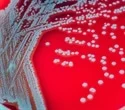
Have you ever been so hungry that you became angry, also known as being “hangry”? According to Adam Rosenthal, PhD, assistant professor in the Department of Microbiology and Immunology, some bacteria cells get hangry as well, releasing harmful toxins into our bodies and making us sick.
Rosenthal and his colleagues from Harvard, Princeton, and Danisco Animal Nutrition discovered, using newly developed technology, that genetically identical cells within a bacterial community have different functions, with some members being more docile and others producing the toxins that make us sick.
The findings, published in Nature Microbiology, are especially important in understanding how and why bacterial communities delegate duties to specific cells – and may lead to new approaches to antibiotic tolerance in the future.
Rosenthal decided to investigate why some cells behave as “well-behaved citizens” while others behave as “bad actors” tasked with releasing toxins into the environment. Clostridium perfringens, a rod-shaped bacterium found in the intestinal tracts of humans and other vertebrates, insects, and soil, was chosen as his microbe of study.
They were able to decode every single cell by separating, or partitioning, single bacterial cells into droplets using a device known as a microfluidic droplet generator.
They discovered that the CRosenthal wonders if there are specific environmental factors that may be ‘turning on’ toxin production in other types of infections now that they know nutrients play a significant role in toxicity, or if this new finding is only true for C. perfringens.
Most importantly, Rosenthal believes that feeding nutrients to bacteria could provide a new alternative treatment for both animals and humans.
Clostridium perfringens, for example, is a formidable foe in the hen house. As the food industry transitions away from antibiotic use, poultry are left defenseless against the rapidly spreading, fatal disease. Rosenthal et alrecent .’s findings may provide farmers with a new tool for reducing pathogenic bacteria without the use of antibiotics.





